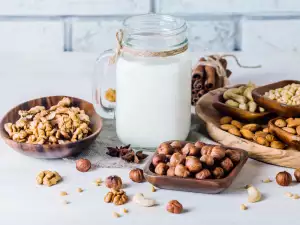Dairy products are a column in the food table that is an integral component of a complete diet. Although veganism somewhat denounces animal foods, including milk and animal products, no one can deny that it is a biological fluid through which life develops.
Dairy products incorporate dairy beverages, soft, hard and smelly cheese, and yogurt. Some of them are derived from whole, others from a skim milk ensemble which undergoes lactic acid infusion and alcoholic fermentation. The source product for most dairy products are cow's milk, buffalo milk, goat's, sheep's milk and some others.
Dairy is a source of useful nutrients that are important for our health. Because of the processing industry and dubious methods of breeding, there were theories that reasonably demonstrate that the milk we drink, is not the true and pure product that our ancestors used.
Lactic acid products are suitable for use by adults and children, but with some uncertainty. For example, over a certain age, the consumption of milk should be kept to a minimum because of the difficulty levels, which the body finds with processed milk.
Because milk is a perishable product in the course of time, people have found a way to "harness" a variety of other products that are much more resistant and durable. Using different types of lactic acid bacteria is the key to the variety of these foods.
It causes fermentation and produces various yoghurts. The end result of the vital activity of lactic acid is producing microorganisms for a variety of dairy products today, popular and even famous for its healing properties.
Types of dairy products
Milk, as a starting product for the preparation of various dairy products, is mixed with different compositions depending on the origin, which is one of the reasons in a variety of flavors and fragrances of dairy products.
First you would have to mention the Bulgarian yogurt, which is distributed worldwide. The main bacteria in Lactobacillus Bulgaricus and has countless proven preventive and curative properties. Curd is a product that can easily be obtained from the curdling of milk. It is obtained by the use of lactic acid streptococci and resembles Italian ricotta.

In other countries, there are other popular products such as lactic acid, Mazzola and acidophilus milk, kefir, koumiss and others that utilize a variety of lactic acid bacteria. Some of the most popular country are acidophilus milk and koumiss, the last of which was known thousands of years ago as a healing and refreshing drink.
The colorful range of dairy products is complemented by a wide variety of cheeses produced worldwide that are fascinating and with unique tastes, which depend on the type of milk, technological progress, climate, and ultimately even the food the animal swallowed.
France is something of a mecca for different and aromatic cheeses. The country enjoys over 150 local cheeses that are a real temptation for the palate. Other popular options are Italian, Dutch, Austrian, German, English and Belgian cheeses. Cheddar, Roquefort, Gorgonzola, Gouda, Parmesan are among the most popular.
There are two main types of cheese - brined white and yellow, which are the hallmark of native milk processing. Dairy specialties include cream cheese and river cheddar cheese, known for its high fat and soft texture.
Standard quality of dairy products
Because of acute problems related to the quality of manufactured dairy products, in recent years have been introduced austerity measures and strict requirements regarding the method of manufacture of yogurt, feta and other cheeses. Until recently, the production of milk and cheese used huge amounts of vegetable oil, which is inherently unacceptable, and these products should not be called dairy.
Common practice is to use machines that can mix vegetable and animal fats, but the finished product is with questionable quality and in no way can be called a complete dairy product. Processors and manufacturers who want to sell such mixtures in the supply chain have a red light in the use of the name "dairy product". According to experts, these foods should be called only "plant products".
Composition of dairy products
As a rule, the milk of animals is a valuable source of high quality protein and most easily digestible calcium. The composition of milk has phosphorus, known amounts of many other minerals (except iron). Milk and dairy products contain the full spectrum of vitamins, the greatest importance is the quantity of vitamin B2. It is important to note that insufficient intake of milk and dairy products causes insufficient import of calcium and vitamin B2.
High quality, real whole milk delivers significant body fat. Any dairy product has fat in different doses and all other vitamins and minerals. Commercially available are also some low-fat dairy products. Semi-skimmed milk is with 2-1% fat and skimmed milk contains 0.1%. The percentage of fat in whole milk curds is about 16%, but cottage cheese contains only 0.6% fat.

Dairy products are also butter and cream, which are sources mainly of fat and vitamin A. Much of the cheeses are an important source of protein (16-30 g/100 g) and calcium (200 to 1200 mg/100 g). They contain 3-6 times more vitamin A than milk and 2 times more vitamin B2.
Their doses of folic acid are also much larger than milk. With cheese, sugar is almost completely digested. Most fat is in yellow cheese (30-60%), which is a red light, suggesting that its consumption should be done carefully. Cow cheese is considered far more dietetic, because it contains about 19 grams of fat per 100 g.
The nutritional parameters of yogurt are larger than milk, because the protein and lactose in it are absorbed better. In addition, lactic acid bacteria produces additional B-group vitamins in the human stomach.
We should explain that the main protein in cow's milk and most animal milks is casein (approximately 80% of the total), which is associated with calcium.
"Curdling" of milk comes under the influence of acids and enzymes, leading to the disintegration of the casein-calcium complex. Casein forms "coagulants", or clots. This process underlies the absorption of the main dairy protein in the stomach and, of course, changes in the milk production of dairy products. Cheeses use special "rennet" ferments, while lactic acid products use lactic acid.
In human milk, the basic protein is albumin, which is absorbed into the digestive track much better than casein. This is because it forms much smaller protein clots. Mare and donkey milk is albumin milk. There is no better food than breast milk for newborns, because it contains so called immunoglobulins that transmit the immunity of the mother to the newborn.
Storage of dairy products
Dairy products are relatively durable enough to follow basic rules to store, but cheese and milk are different. Pasteurization is the process that makes long and full storage of milk possible. As cheeses get more rigid, their durability is higher. Soft cheeses are the most perishable.
Certain dairy products are suitable for freezing. For example, the shelf life of milk in freezers is 2-3 months. The cream is frozen in small plastic containers and freezing it possible, as it has a neutral and broken form.
Soft cheeses from dairy products are more suitable for freezing than hard ones. Wrap them in aluminum foil or plastic, even if it is a separate small plate of cheese. Their storage time is 6 to 8 months. You can freeze butter, for maximum durability, it is good to wrap it in plastic wrap. You can keep butter frozen for up to 6 months.
Culinary use of dairy products
Dairy products are widely used in various cuisines around the world. Milk and yogurt are used in many desserts and meals, consumed alone are used in many meat and vegetable dishes. Cheese and feta are also very popular - in many dishes and appetizer. Everyone can consume dairy products according to their individual tastes and preferences.
Benefits of dairy
Lactic acid produced by the impact of lactic acid bacteria inhibits the growth of harmful microorganisms not only in milk, but also in the human gut. Dairy products are a source of large numbers of live lactic acid bacteria that inhibit, in some cases even stop, the growth of harmful microorganisms in the intestines that cause disease.

The calcium in dairy products is a mineral that is vital for building strong bones and teeth. Insufficient intake of milk and dairy products may increase the risk of osteoporosis. Yogurt is invaluable for its health properties. It is a source of probiotics that contain live microorganisms.
These little friends of ours have many benefits for our health. Lactic acid bacteria have a strong antimicrobial activity by inhibiting reproduction of harmful bacteria in food and the gut, thereby reducing the incidence of intestinal disorders. They are important for small children, who often get rapid dehydration from diarrhea, with severe consequences.
Lactic acid bacteria are important for good digestion, and have the ability to reduce constipation. They have a beneficial effect on the immune system, reducing the risk of atherosclerosis because they cause lower blood cholesterol. Even if it is proven that these bacteria are able to lower carcinogenic elements and enzymes in the intestine, suggesting that they are an important tool in preventing cancer.
Formed in the fermentation process bioactive peptides lower blood pressure, boost immunity and reduce the formation of blood clots. Calcium also helps to reduce blood pressure. In addition, dairy products are good for your teeth, reducing the chance of developing tooth decay.
This is because milk is alkaline and neutralizes the acids created during fermentation of sugars in the mouth, which can be harmful to teeth. The bacteria in yogurt kill microorganisms growing in the mouth. Regular consumption of dairy products, including, cheeses, will ensure an adequate intake of calcium, protein and phosphorus.
Dangers of dairy products
Dairy products in recent years have become a bone of contention. Opinions are polarized, on one side stand proponents, on the other - the opponents of these foods. The World Health Organization and all national associations of Nutrition and Dietetics recommend regular consumption of milk and dairy products. At the same time, respected nutritionists call milk "white poison".

As for cow's milk, an incorrect manner of raising the animals suggests that cows are injected with hormones to produce faster and larger doses. These cow hormones are stored in the milk we consume. Dairy products such as cow's butter, cream, whole milk and cheese are a major source of fat and saturated fatty acids, which automatically increases the risk of obesity and heart disease.
It is claimed that the excessive use of such dairy products may be associated with a greater incidence of cardiovascular disease and even cancer of the prostate and kidney. Some experts strongly recommend the use of low fat/fat-free milk and dairy products.
Some people, mostly elderly and children often have deficiency of the lactase enzyme, which breaks down milk sugar. In such cases problems such as stomach aches, cramps and pains, gas, and diarrhea often occur. These people should not consume milk and even cheese, which has minimal amounts of milk sugar.
There is a theory that is categorical that the early introduction of milk (before 9 months) to infants may increase the risk of developing an allergy to milk. It is known that goat milk causes fewer allergies than cow. In addition, more than 1 liter of milk per day in young children could lead to anemic conditions, due to its low content of iron.
Furthermore, early milk consumption in early childhood increases the levels of antibodies to cow's milk and increases the risk of developing autoimmune disease and diabetes if the child has a diabetic parent. Some people who regularly eat cheese often have headaches, because of milk protein products form tyramine amines, a cause of migraines.




















Comments